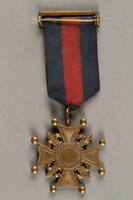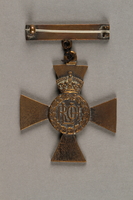Overview
- Description
- The collection consists of biographical material, correspondence, writings, and photographs documenting the Holocaust-era experiences of Anne Ranasinghe (born Anneliese Katz), originally of Essen, Germany, including her immigration to England as a refugee in January 1939, and her post-war career as a poet and writer in Colombo, Sri Lanka. The papers include research regarding the fates of her parents Anna and Emil Katz, letters to Anne from her parents in Essen from 1939-1940, Anne’s wartime diary, post-war correspondence, poems, essays, and related writings, and family photographs.
Biographical material of Anne’s includes photocopies of her German and English passports, her birth certificate, and material related to the Cross of the Order of Merit of the Federal Republic of Germany awarded to her in 2015. Other material primarily relates to research regarding the fates of her parents and relatives during the Holocaust.
Correspondence includes letters and postcards sent to Anne in England from her parents in Essen from 1939-1940, a 1939 letter from the German Jewish Aid Committee acknowledging her letter to Prime Minister Neville Chamberlain regarding her parents situation, post-war letters from Anne to Maria Stern, who sponsored her immigration to England in 1939, and post-war correspondence regarding the Alte Synagogue in Essen, the Heimsuchung documentary, her family history, and her work. Also included are letters received from Elie Wiesel, Israeli President Shimon Peres, and Buckingham Palace on behalf of Queen Elizabeth.
Writings include Anne’s diary, written from 1939-1947 in both German and English. The bulk of the diary consists of entries from 1939-1941, and also includes several drawings and poems in the back. English translations of several entries from 1939 are also included with the papers. Other writings of Anne include essays, poems, text for an exhibition at the Alte Synagogue in Essen, and the script for a Purim play she wrote in 1936. Additional writings include clippings regarding Anne’s life and work, papers regarding the Heimschung documentary, Emil Katz’s English speech written while trying to learn English to aid in emigration from Germany, and a photocopy of a chapter in a book by Paulgehard Lohmann regarding the history of the Jews of Fritzlar, Germany, including the Katz family.
Photographs include a pre-war photograph album of Anne, her family, and friends, pre-war, wartime, and post-war pictures of Anne, and depictions of her performing in her Purim play in 1936. Other photographs include pre-war depictions of Essen, the Jewish youth center (Jugendheim) where Anne spent time with the Maccabi Hatzair Zionist youth group, and the Katz family and related relatives.
Visual media consists of a VHS cassette copy of the Heimsuchung documentary chronicling Anne’s visit to Essen and Züschen in 1985. - Date
-
inclusive:
1914-2017
bulk: 1936-2017
- Credit Line
- United States Holocaust Memorial Museum Collection, Gift of Shanti Conly
- Collection Creator
- Anne Ranasinghe
- Biography
-
Anne Ranasinghe (1925-2016) was born Anneliese Henriette Katz on 2 October 1925 in Essen, Germany to Jewish parents Emil and Anna Katz. Emil Katz (1892-1944) was born on 16 August 1892 in Züschen, Germany to Joseph (1850-1905) and Marianne (d. 1933) Katz. He had eight siblings: Max (1878-1942), Victor (1884-1942), Julius (1885-1942), Hermann (1885-1914?), Lina (1887-1943), Klara (1889-1942), Moritz (1890-1915), and Sophie (1894-1943). He married Anna on 3 November 1924 in Essen. Anna Katz (born Aenne Amalie Mendel, 1902-1944) was born on 17 March 1902 in Cologne, Germany to Paula (1878-1942, née Stern, born on 23 October 1878 in Kamen) and Alfred Mendel. Alfred died when Anna was very young, and In 1908 Paula married Joseph Heiser (b. 5 May 1876 in Breitenbach), and they had a daughter Liselotte (1911-1986, later Lotte Nienaber).
Emil was a World War I veteran and his brothers Hermann and Moritz were both killed during the war. He owned a small factory that manufactured sanitary items. Although the family lived in Essen, in 1936 Anne began traveling daily to attend the Jewish Gymnasium in Cologne (the Jawne) since Jewish children were no longer permitted to attend the regular school in Essen. As a child, she also developed an interest in writing. Her family was religious and regularly attended Synagogue. Anne was also active in the Maccabi Hatzair Zionist youth group.
During Kristallnacht (9-10 November 1938), the Katz family witnessed the burning of the Essen synagogue, and Anna and Anne were alone in their apartment when it was attacked on the evening of the 9th. Emil was arrested on the morning of 9 November. He was first sent to prison and later to the Dachau concentration camp. After sustained efforts by Anna, Emil was released from Dachau on 28 November. Anne’s parents decided to send her to England, with her grandmother’s brother, Dr. Ernst Stern and his wife Maria acting as her sponsor. On 26 January 1939 Emil took her as far as the Dutch border, arranged for her passage, and asked some Catholic nuns to look after her in the ship’s crossing from Flushing, Netherlands to Harwich, England. From Harwich, she travelled alone to Londonl to meet her great aunt. She stayed a few days with her, then was sent alone to the Parkstone Girls Grammar school in Dorset. When the war broke out in September, she was considered an “Enemy Alien” but was allowed to stay in school. Anne was able to remain in communication with her parents through letters sent via her father’s Dutch business partner, but after the German invasion of the Netherlands, all communication stopped.
By 1941, Anne’s father had lost his factory and her mother worked as a secretary. On 27 October 1941 Emil and Anna were deported to the Łódź Ghetto. On 10 July 1944 they were deported to the Chełmno extermination camp where they were murdered upon arrival. Anne did not learn the full story of her parents’ deaths until 1991. All of Emil’s siblings and Anna’s mother perished during the Holocaust.
From 1940-1941, the Germans conducted bombing raids on London and surrounding areas, and Anne survived the bombing of a theater in East Grinstead. In 1942, as part of her war service and to earn a living, she began training as a nurse at various London hospitals. She earned a midwifery degree at King’s College Hospital, where she met her future husband, Professor D. A. Ranasinghe, a Sri Lankan widower with three children who was earning a post-graduate degree there. They married in 1949. He returned to Sri Lanka where he was a member of the Medical Faculty at the University of Colombo (and later Chancellor of the University). Anne joined him in 1952 with their new baby. They had seven children including the three from his previous marriage.
By 1975, Anne had returned to writing, including an Amnesty International newsletter published through an office in her house, essays, and poems. Much of her work focused on themes related to the Holocaust. She was considered one of Sri Lanka's leading English language poets, and won several international awards. In 1985 she returned to Essen and her father’s hometown of Züschen for the first time since leaving in 1939. Her visit became the subject of Michael Lentz’s documentary Heimsuchung for German television. She was awarded the Cross of the Order of Merit of the Federal Republic of Germany in 2015. Additionally, a 1936 photograph of Anne in costume performing her Purim play is featured in the Daniel’s Story exhibition in the United States Holocaust Memorial Museum.
Physical Details
- Extent
-
1 boxes
3 oversize boxes
3 oversize folders
- System of Arrangement
- The collection is arranged as five series:
Series 1. Biographical material, 1938-2017
Series 2. Correspondence, 1939-2015
Series 3. Writings and publications, 1936-2016 and undated
Series 4. Photographs, 1914-circa 1990
Series 5. Visual media, 1986
Rights & Restrictions
- Conditions on Access
- There are no known restrictions on access to this material.
- Conditions on Use
- Material(s) in this collection may be protected by copyright and/or related rights. You do not require further permission from the Museum to use this material. The user is solely responsible for making a determination as to if and how the material may be used.
Keywords & Subjects
Administrative Notes
- Holder of Originals
-
United States Holocaust Memorial Museum
- Legal Status
- Permanent Collection
- Provenance
- Donated to the United States Holocaust Memorial Museum by Shanti Conly in 2018. Shanti is the daughter of Anne Ranasinghe.
- Funding Note
- The accessibility of this collection was made possible by the generous donors to our crowdfunded Save Their Stories campaign.
- Special Collection
-
Save Their Stories
- Record last modified:
- 2024-04-11 13:18:48
- This page:
- https://collections.ushmm.org/search/catalog/irn611478
Additional Resources
Download & Licensing
In-Person Research
- Available for Research
- Plan a Research Visit
-
Request in Shapell Center Reading Room
Bowie, MD
Contact Us
Also in Anne Ranasinghe collection
Photographs, documents, and memorabilia related to the donor’s mother, Anneliese Katz (later Anne Ranasinghe), her childhood in Essen, Germany and immigration alone to England at age13. Includes a small photograph album; loose photographs; a diary (approximately 100 pages, covering 1939-1947 [bulk 1939-1942], in German with some English poems and phrases); wartime letters and postcards from Annaliese’s parents in Germany; miscellaneous correspondence; family history material; Alte synagogue Exhibition document, nursing badges, and order of merit awarded by German government.
Date: 1914-2017






